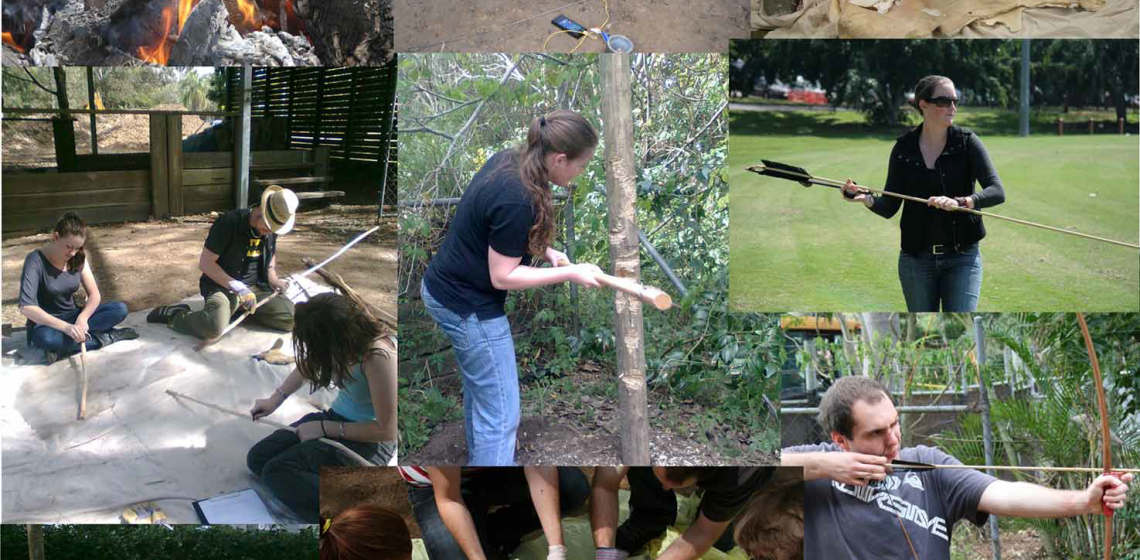
The University of Queensland runs a biannual course ‘Ancient Technologies: Experimental and Analytical Approaches to Understanding (ARCS2010)’. This course was developed by Prof Chris Clarkson and is coordinated by Dr Ben Schoville until 2021 while Clarkson is on a research fellowship.
ARCS2010 will build understanding of the principles, evolution and sophistication of ancient technologies. Experimental archaeology is an important arm of archaeological research used to develop and test hypotheses about the practicalities, operational conditions and limitations of prehistoric technologies. The course will cover the anthropological theory of technology, the principles and objectives of experimental archaeological science, the origins and evolution of complex technology, and how technology can inform us about past human societies and cultural change. The course will introduce students to current systems of technological analysis in archaeology and archaeometry, including lithic and ceramic analysis, metallurgy, classification, and microscopic analysis of artefacts. The course includes hands-on experimentation with ancient technologies in weekly practicals.
The course involves 13 weekly practicals centered on integrating experiments, data collection and the theoretical underpinnings of ideas about technology, design, efficiency, performance characteristics and the evolution of technology. Practicals include tool use efficiency experiments with scrapers, knives, drills, and axes of stone, bone, copper, bronze and iron. Early hominin behaviour is explored through nut cracking, butchery and marrow extraction practicals. Early cognition and transformation of raw materials is explored through a heat treatment exercise with silcrete. Projectile experiments test accuracy, skill, penetration depth, and projectile tip damages and explore the origins and effectiveness of different projectile systems such as spears, atlatls, and the bow and arrow. Students make their own antler point using stone tools and haft stone projectile points using resin, sinew and animal glue. For plant processing, students trial various kinds of grindstones with various kinds of hard and soft seeds. They also test sickles of various designs and compile data on efficiency and quality of outputs. Ceramics practicals look at the effects of temper on malleability and strength, hand versus wheel thrown construction on production marks and finesse, and firing experiments compare open firing and kiln firing for regularity, colour and sintering. Class products are compared to archaeological examples in the university Classics museum. Metal casting practicals look at such factors as forge size, bellows construction and different alloys and their effects on efficiency. Students cast tools, personal adornments and weapons in copper and bronze in clay bivalve moulds built by the students. The glass practical melts glass in a simple glass forge with students winding glass beads onto mandrels and attempting primitive glass blowing. Students complete fortnightly practical worksheets for assessment, linking their data to key readings and ideas. They also submit a 10 minute Youtube video on an experiment of their own choosing for their final assessment. Example videos can be found on the Clarchaeology channel on YouTube.
A paper written about the course:
Clarkson, C. and Shipton, C., 2015. Teaching ancient technology using “hands-on” learning and experimental archaeology. Ethnoarchaeology, 7(2), pp.157-172.
Abstract:
Universities increasingly demand high quality courses that are engaging, develop high level analytical skills and foster deep understanding of key disciplinary subject matter. We describe an approach to teaching ancient technology to undergraduate students that is successful in engaging students through hands-on learning, and develops familiarity with general scientific approaches to building knowledge, while also enabling deeper understanding of core archaeological skills and subject matter, such as artifact analysis and the evolution of technology. There is value in sharing approaches to teaching ancient technology and experimental archaeology and we hope others will find this discussion helpful in developing their own courses or comparing our approach with those which are already on offer.
